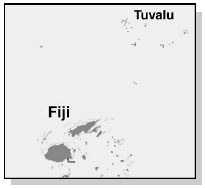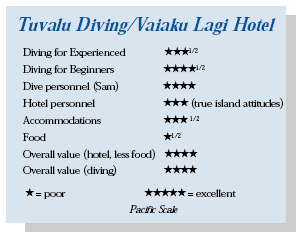Tuvalu, South PacificContents of this Issue: One More Bahamas Boat, the Rorqual What You See When You Dive Deeper Readers Lose Money with Scubacan Think You’ve Made Your Last Dive? Editorial Office: Ben Davison Publisher and Editor Undercurrent 3020 Bridgeway, Suite 102 Sausalito, CA 94965 a trip back in time, when there were no dives from the February, 2002 issue of Undercurrent
You know the dream. The one where you’re the only diver at the resort and the entire operation and all the sites are yours and yours alone. How about being the only diver in the entire country? In October I had that experience in Tuvalu, one of the smaller and more isolated countries on Earth. Consisting of nine islands totaling 16 square miles and home to 9,000 people, Tuvalu lies 700 miles north of Fiji. Air Fiji now flies twice a week from Fiji on a modern, 30-seater turboprop. Flight time is 2 hours and 15 minutes. Upon arrival at the main islet of Fongafale, inquiries led me to Semese Alefaio, conservation officer for the Funafuti Conservation Area Project. A cheerful Tuvaluan in his late twenties, Sam is earnest and soft spoken -- in English and Japanese. Anything you want in the way of diving, he will try to provide. In laidback Tuvalu, his energy and eagerness to learn stood out. Encompassing about a third of the huge main atoll of Funafuti (12 x 16 miles), the two-year-old conservation area was what drew me to Tuvalu. It was a leap into the unknown. No formal dive operation existed in Tuvalu, and I didn’t know if I would even be able to dive. But, the Fisheries Department had a compressor, aluminum 3,000+ psi tanks, and Sam offered to take me out. An enterprising young man, he has just started that first dive operation. Three main channels enter Funafuti lagoon. My first dive was on the outside
of Te Aua Fuagea. Inside the lagoon’s Conservation Area, where
boat rides are 10-30 minutes long, undersea life
exploded. Clouds of small basselets and damsel
fish, anthias, rabbit fish, shoals of bait fish,
wrasses and parrotfish were present in joyful abundance.
Multiple species of hard coral were not just
thriving, but flourishing, in water warm enough to
make tea. The water temperature was 88 degrees and
on none of my dives did it drop below 85 degrees. Incredible. I did a solo dive on American Channel (so called because during WWII Seabees blasted and enlarged it to allow ships to enter). Solo, because Sam had to stay with the boat, as there was no anchorage. (Sam assumed I knew what I was doing, or I wouldn’t have been there in the first place; when diving, he was there when I wanted him, away when I didn’t.) He thought I was the third sport diver ever to enter the channel, which was lined with lush coral. Despite the dimming caused by looming rain clouds, I still had 100 ft. viz. Twenty trevally joined me, perhaps to escape the vigilant white-tip that followed. Personally, I was more concerned about the cluster of Triton triggerfish that kept charging. These colorful but highly territorially aggressive fish have big front teeth and a habit of using them. I saw several 3-4 foot handsome coral and speckled cod, an encouraging sign since they have been largely hunted out elsewhere in the Pacific. Then I found the bomb. OK, so maybe it wasn’t a bomb. But it was big, fat, and rusty, and had little fins on the bottom. It also had a big chain attached to where the detonator would be. Probably an empty bomb casing that had been filled with concrete and used as a weight. I finned around it at a respectful distance anyway. Funafuti lagoon is full of WWII relics, most of them undocumented. It had been cloudy but calm when I had gone over the side. I surfaced in the midst of a driving rain squall, with virtually no visibility. Trusting in Sam, I spent the next two hours sitting in the front on the bottom (no seats in the boat) of the 18-foot open aluminum skiff as we slammed through wave after wave, getting thoroughly soaked by salt spray while I pretended I was Ahab rounding the roaring Forties. It was exhilarating, but scary. When eventually the town emerged from the squall, I was never so glad to see a cheap hotel in my life. (Sam is awaiting the delivery of a New Zealand-built aluminum dive boat, with covered front end, head, twin Yamaha 60s, and tank racks. It’ll be the best boat in the country, bar the Australian navy patrol boat that’s based there). Vaiaku Lagi, the one hotel, was built as a gift by the Taiwan government. Nine years old, it shows some wear. The 16 rooms ($45/night) in the new wing (forget the old wing) are well-appointed and kept spotlessly clean, with decent air-conditioning, a ceiling fan, refrigerator, large bathroom with shower, desk, closet space and both a single and queen bed. A sliding glass door opens onto a small deck with a table and two chairs. Second-floor rooms have wonderful sunset views over the lagoon. The fan was mounted directly next to the light. Turn both on and the strobe effect caused by the fan blades passing in front of the light will drive you nuts. Though the roof of the hotel boasts solar hot water heaters, there was no hot water during my stay. On the other hand, the cold water isn’t really cold, either. Hotel meals are filling and basic: a tuna steak or chicken, rice and vegetable for $3-$4. Though a cold breakfast is set out every morning, you can get toast or eggs, but you have to ask. The bar does business every evening, a great way to meet the locals. Friday and Saturday nights there is a twist, or disco, during which astounding quantities of Victoria Bitter beer are consumed to the thunder of speakers whose bass is cranked up beyond belief. Ask for a room as far from the bar as possible. Occasionally, displays of Tuvaluan dancing and singing are performed. Tuvaluan dancing is faster than Hawaiian and slower than Tahitian, but the music, hammered out by groups of men on a few skin drums, is tremendously percussive. Think a Polynesian version of Ravel’s Boler . When the weather cleared the following day, at Moon Jelly Mountain, I saw dozens of lavender-hued, yard-wide jellyfish drifting lazily around a bommie. I was becoming inured to the profusion of coral and reef fish life, until a lonely yardlong, black and white remora decided to stick with me despite numerous kicks and waving of hands. Swimming up to Sam, it materialized right in front of his mask. On the lookout for sharks, Sam nearly dropped his cookies. After lunch, we visited an unexplored bommie south of Funafuti near an islet named Papa Elise. Rising from the bottom at 60 feet and washed by a slight, gentle swell, the bommie was completely swathed in as colorful an explosion of hard corals as one could hope to see. Spiraling upward, we encountered a turtle under a cleft, hard corals as delicate (and unbroken) as ice crystals, a charming swimthrough, a small cave lined with columnar black sponges and lavender soft corals of the kind associated with Fiji and PNG, hundreds of unicorn fish, and clouds of reef fish. During our safety stop on top of the bommie, a big, muscular, gray reef shark spent a few minutes looking us over. “What do you want to call it?” Sam asked me when we were back on the boat. I thought for a moment. Staghorn coral lined the lower levels of the bommie, which was topped by several castle-like coral formations. There was the magic cave, the swim-through, and even a dragon of sorts in the person of the gray reef. “Sleeping Beauty’s Castle,” I told him. And thus are dive sites named. Nearby, we crossed a rough-water passage in the reef where a couple of years ago a group of divers off an American yacht were forced out of the water by a pack of incredibly aggressive gray reef sharks. Pursuing them to the surface, one shark bit so big a hole in the yachties’ inflatable that the party only made it back by seating everyone on the starboard side, to keep the rip out of the water. The sharks, supposedly, followed them all the way back to the boat. Sam says they never dove the lagoon again. Funafuti reminded me of French Polynesia thirty years ago. The children smile and try to talk to you, the men still wear flower garlands in their hair when going to work, and the women gossip incessantly. There is no TV in the country that markets the dot.tv Internet suffix (there was, but the equipment corroded and hasn’t been replaced). There is no media except the free monthly newspaper Tuvalu Echoes, put together by Sam’s wife. There’s nothing much to see on Fongafale, an utterly flat spit of tree-covered land. The landing strip occupies the widest part, while in the north the island is barely wide enough to accommodate the road. Houses are everywhere; some built with concrete blocks, others that are thatched single-room structures on stilts. Situated right next to the airstrip, the “town” of Vaiaku consists of a market, a Tuvaluan falekaupule (open-sided meeting house), the two-story bank, the tiny airport terminal, a few government offices, one market, the hotel, Filamona’s guest house with its Chinese restaurant, and the Australian naval facility. The hospital is a mile north of town. With the nearest hyperbaric chamber in Fiji and only two scheduled flights a week, this is no place to get bent. A brief tour of the famous Tuvaluan Marine Training Institute on nearby Amatuku Island, which trains Tuvaluans for service in the world’s merchant marines, was interesting. The Women’s Handicraft center at the airport has some simple shell jewelry and mats for sale. Much more interesting are the model Tuvaluan fishing outrigger canoes; each takes three months to make, by hand, and costs all of $25. If you want to step back in time, to experience what remains of real Polynesia, and want to have the opportunity to dive pristine, undived sites in beautiful, truly laid-back surroundings, then Tuvalu is, perhaps, just for you. I wouldn’t recommend it as the first destination on a Pacific itinerary, unless of course you want to be the only tourist diver in an entire country. -- J.L. |

I want to get all the stories! Tell me how I can become an Undercurrent Online Member and get online access to all the articles of Undercurrent as well as thousands of first hand reports on dive operations world-wide
| Home | Online Members Area | My Account |
Login
|
Join
|
| Travel Index |
Dive Resort & Liveaboard Reviews
|
Featured Reports
|
Recent
Issues
|
Back Issues
|
|
Dive Gear
Index
|
Health/Safety Index
|
Environment & Misc.
Index
|
Seasonal Planner
|
Blogs
|
Free Articles
|
Book Picks
|
News
|
|
Special Offers
|
RSS
|
FAQ
|
About Us
|
Contact Us
|
Links
|
3020 Bridgeway, Ste 102, Sausalito, Ca 94965
All rights reserved.

 While there was plenty of reef life, including a green turtle, a
Maori wrasse, and a white-tip shark, the coral was
a bust. Cyclone Bebe, which devastated Tuvalu in
1972, had left little outside the reef but rubble.
Some nice gorgonians and a few isolated corals were
all that broke the monotony.
While there was plenty of reef life, including a green turtle, a
Maori wrasse, and a white-tip shark, the coral was
a bust. Cyclone Bebe, which devastated Tuvalu in
1972, had left little outside the reef but rubble.
Some nice gorgonians and a few isolated corals were
all that broke the monotony.  You could dive naked in
Tuvalu and still be warm. Yet, not one
sign of bleaching. Apparently, Tuvalu’s
mid-ocean isolation, combined with eons
of adaptation, has allowed the corals
to survive in temperatures that have
killed their relatives elsewhere. It
was a heartening sight. On the way
back, Sam took down the names of two
small boatloads of fishermen we caught
poaching in the conservation area.
Though a new concept for Tuvalu, conservation
regulations are being
enforced -- which is more than many
Pacific countries can claim.
You could dive naked in
Tuvalu and still be warm. Yet, not one
sign of bleaching. Apparently, Tuvalu’s
mid-ocean isolation, combined with eons
of adaptation, has allowed the corals
to survive in temperatures that have
killed their relatives elsewhere. It
was a heartening sight. On the way
back, Sam took down the names of two
small boatloads of fishermen we caught
poaching in the conservation area.
Though a new concept for Tuvalu, conservation
regulations are being
enforced -- which is more than many
Pacific countries can claim.  Diver’s Compass: Best time to visit is between May and September
... Sodas and imported NZ water, a buck each, beer and booze more.
Rooms serviced daily, though not on Sunday, when country (but not
Sam) shuts down. The new Filamona’s Lodge, near the airport, has A/C
doubles $28, singles $24, no A/C, $18. Telephone: 011 (688) 209-83.
Filamona’s serves the best food -- try the steamed fish or Mongolian
chicken, with a big bowl of white rice, for $4. There are a number
of small guest houses on Fongafale, but the tiny guest house on
distant Funafala Island (pop. 24) is too far away to make diving
workable. If you want to get away from the big city, ask to be marooned on one of the beautiful, lushly vegetated motus (islets) on the other side of the lagoon for a
night. Make hotel reservations: 011-688-20-500. Take cash or traveler’s checks to
exchange at bank; everyone and everyplace expects to be paid in cash. You can rent
bicycles, scooters, or motorbikes. Tuvalu may have the highest per capita population
of four-wheel drives in the Pacific -- all going back and forth along the one main
road, headed for nowhere. Mosquitoes are non-malarial and few. For diving, contact
Semese (Sam) Alefaio. You can reach him via e-mail:
Diver’s Compass: Best time to visit is between May and September
... Sodas and imported NZ water, a buck each, beer and booze more.
Rooms serviced daily, though not on Sunday, when country (but not
Sam) shuts down. The new Filamona’s Lodge, near the airport, has A/C
doubles $28, singles $24, no A/C, $18. Telephone: 011 (688) 209-83.
Filamona’s serves the best food -- try the steamed fish or Mongolian
chicken, with a big bowl of white rice, for $4. There are a number
of small guest houses on Fongafale, but the tiny guest house on
distant Funafala Island (pop. 24) is too far away to make diving
workable. If you want to get away from the big city, ask to be marooned on one of the beautiful, lushly vegetated motus (islets) on the other side of the lagoon for a
night. Make hotel reservations: 011-688-20-500. Take cash or traveler’s checks to
exchange at bank; everyone and everyplace expects to be paid in cash. You can rent
bicycles, scooters, or motorbikes. Tuvalu may have the highest per capita population
of four-wheel drives in the Pacific -- all going back and forth along the one main
road, headed for nowhere. Mosquitoes are non-malarial and few. For diving, contact
Semese (Sam) Alefaio. You can reach him via e-mail: 